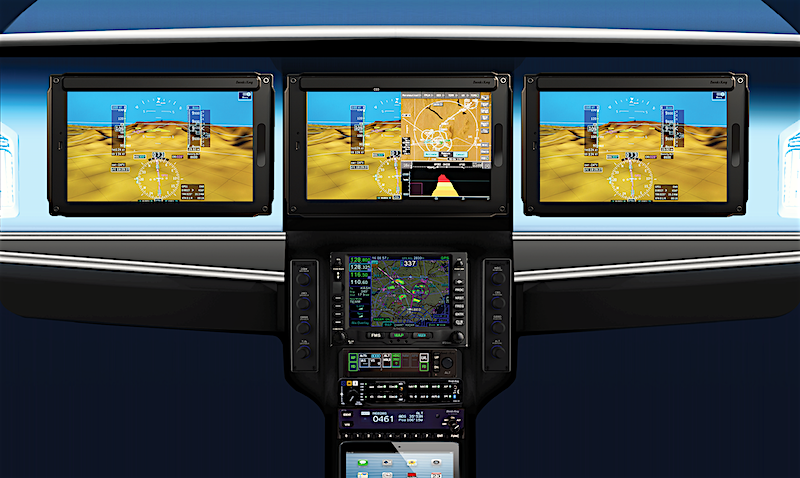
BendixKing’s new AeroVue touch integrated flight deck uses smart displays as flight control computers. Photo: BendixKing
BendixKing’s new AeroVue Touch integrated flight deck takes a disruptive new approach to the traditional concept of display-centered flight decks by embedding computing engines within new smart cockpit displays.
The Honeywell subsidiary showed the new flight deck for the first time at the Aero Friedrichshafen event last week in German, targeting its use as a customizable new pilot interface for Part 23 Class I, II or III aircraft. Although BendixKing executives believe it could be also be configured for in-development urban air mobility vehicles as well.
Using the three different 4K touchscreen smart displays, pilots can control their aircraft’s GPS navigator, transponder and audio panel. There are also knobs included which can control barometer, course, heading, and altitude.
In previous generations of flight decks, BendixKing has used avionics processors and graphics processing units within separate line replaceable units. Those units have traditionally been connected to the cockpit displays using wiring harnesses.
According to Stephane Fymat, vice president of product management for BendixKing, each display on the AeroVue Touch has its own embedded computing engine. Each individual display can be used to fly the aircraft completely on its own, and the flight deck features ADS-B In and Out, bluetooth and Wi-Fi connectivity.
“The system eliminates the need for dedicated avionics units, graphics processing units and their associated wiring harnesses and installation racks. This reduces aircraft weight and increases its range, endurance and payload capacity. It also simplifies installation, reducing the time and cost for either a retrofit installation or a new forward-fit final assembly process,” said Fymat.
By eliminating the need for separate computing modules, the new flight deck weighs 30 to 50 percent less than previous generation BendixKing flight decks. The $99,000 system weighs 57-pounds and can also be installed with an optional second set of independent sensors in its Class III configuration. Standby indicators have also been eliminated in the new flight deck, replaced by a smart multi-function display that also serves as a back up to the three primary flight displays.
BendixKing makes specific references within its product description page to how the integrated flight deck could be customized for hybrid-electric or all-electric propulsion aircraft, such as “wing-borne lift, powered-lift or a combination of the two.”
The engine indicator display is also customizable to individual aircraft type requirements.
“When installed with a second set of independent sensors, which is standard in the Class III configuration, the multi-function display also serves as a full-size backup display, providing ADI, HSI, HDG, SVS, NAV/COM, and A/P modes. This eliminates dedicated standby indicators,” said Fymat.
“It also makes the aircraft much simpler to fly than with a small 3-inch attitude indicator,” he said.
BendixKing is making the new flight deck available in both retrofit and forward fit configurations, with the first installation expected to be complete by the end of 2019.